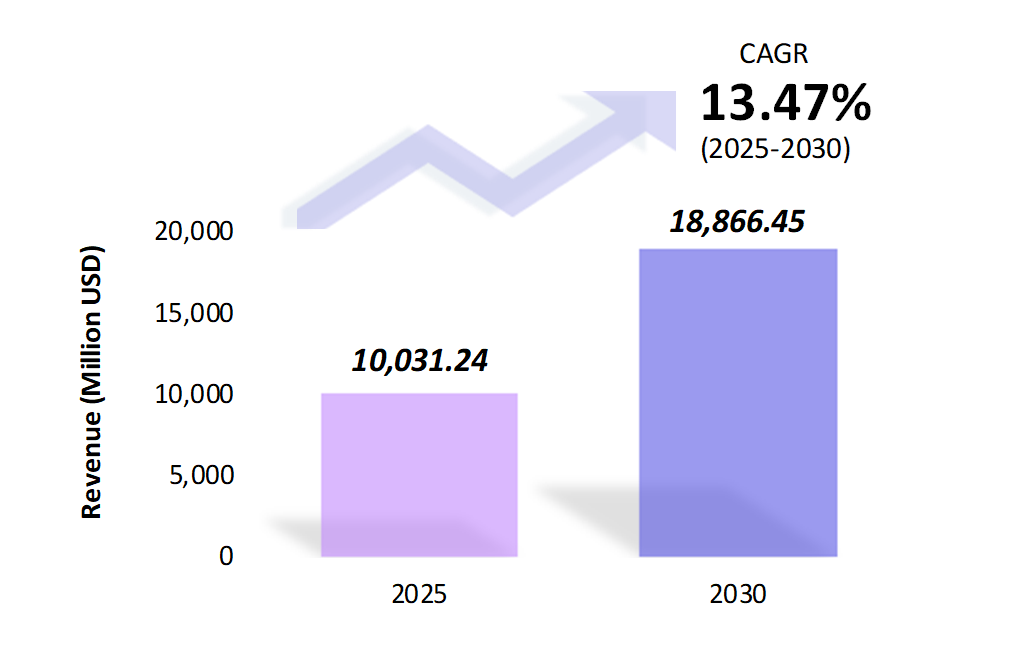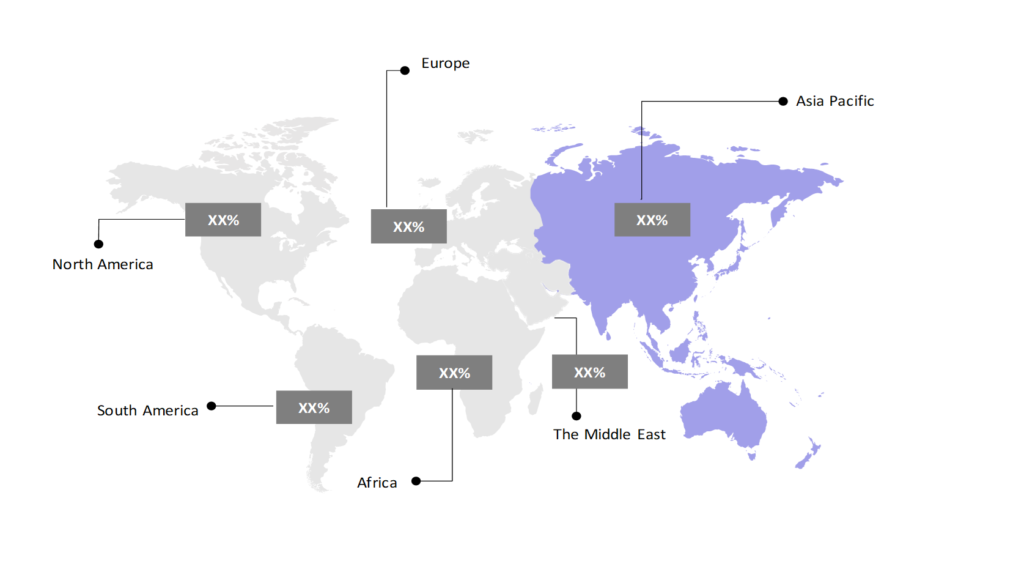Biorational Pesticides Market: Size, Share, Trends & Forecast (2024-2029)
The market report offers a detailed analysis segmented by Type (Biorational Insecticides, Biorational Fungicides, Biorational Nematicides, Biorational Herbicides, Others); by Mode of Application (Foliar Spray, Soil Treatment, Seed Treatment, Others); by Geography (North America, South America, Asia Pacific, Europe, The Middle East, Africa).
Outlook

- The biorational pesticides market is estimated to be at USD 10,031.24 Mn in 2025 and is anticipated to reach USD 18,866.45 Mn in 2030.
- The biorational pesticides market is registering a CAGR of 13.47% during the forecast period 2025-2030.
- The global biorational pesticides market is witnessing significant growth due to increasing demand for sustainable agricultural solutions. Growing awareness about the environmental impact of chemical pesticides and government initiatives supporting organic farming practices is boosting the adoption of biorational pesticides.
Request a free sample.
Ecosystem

- The participants in the global biorational pesticides industry are continuously developing their strategies to preserve a competitive advantage.
- These companies focus on expanding the range of pests, developing microbial-based biopesticides, innovations, acquisitions, R&D, partnerships, and technological launches.
- Several important entities in the biorational pesticides market include BASF Group; Bayer AG; UPL Ltd.; FMC Corp.; Syngenta AG; and others.
Ask for customization.
Findings
| Attributes | Values |
|---|---|
| Historical Period | 2019-2023 |
| Base Year | 2024 |
| Forecast Period | 2025-2030 |
| Market Size (2025) | USD 10,031.24 Mn |
| Market Size (2030) | USD 18,866.45 Mn |
| Growth Rate | 13.47% CAGR from 2025 to 2030 |
| Key Segments | Type (Biorational Insecticides, Biorational Fungicides, Biorational Nematicides, Biorational Herbicides, Others); Mode of Application (Foliar Spray, Soil Treatment, Seed Treatment, Others); Geography (North America, South America, Asia Pacific, Europe, The Middle East, Africa) |
| Key Vendors | BASF Group; Bayer AG; UPL Ltd.; FMC Corp.; Syngenta AG |
| Key Countries | The US; Canada; Mexico; Brazil; Argentina; Colombia; China; India; Japan; The UK; Germany; Italy; UAE; Saudi Arabia; Egypt; South Africa |
| Largest Market | Asia Pacific |
Get a free quote.
Trends
- Emergence of Microbial Pesticides: Microbial-based biorational pesticides are gaining emphasis as they offer targeted pest control without harming beneficial organisms. These include products derived from bacteria, fungi, and viruses. In 2023, Corteva Agriscience launched its new microbial fungicide, designed to sustainably combat diseases like powdery mildew.
- Focus on Bioformulation Technologies: Advances in bioformulation technologies enhance the effectiveness of biorational pesticides by improving their stability and shelf life. This, in turn, allows for more efficient applications and greater user confidence. This innovation also reduces environmental impact by minimizing waste and optimizing resource use in agricultural practices.
- Targeted Pest Management with Precision Agriculture: The adoption of precision agriculture practices emphasizes the use of biorational pesticides. Farmers are utilizing smart technologies, such as drones and IoT sensors, to apply biorational pesticides more targeted and efficiently. By leveraging data analytics and real-time monitoring, farmers can better understand pest populations and environmental conditions, allowing for timely and precise applications of biorational pesticides.
Speak to analyst.
Catalysts
- Rising Consumer Awareness for Organic Products: The rising consumer demand for organic and non-GMO (Genetically Modified Organism) products has prompted farmers to adopt biorational pesticides increasingly. This shift is further fueled by the need for sustainable farming practices and the growing awareness of environmental impact, driving innovation and investment in eco-friendly pest management solutions.
- Government Initiatives and Subsidies: Several governments are providing subsidies and incentives for adopting sustainable agricultural practices, including biorational pesticides. The US Farm Bill 2023 includes provisions for supporting the development and use of sustainable pest management practices, contributing to the market’s growth.
- Environmental Concerns Driving Biorational Pesticide Adoption: The growing environmental impact of chemical pesticides, such as soil degradation, loss of biodiversity, and water contamination, drives the switch to biorational alternatives. Governments across the world are enforcing stricter regulations on the use of synthetic pesticides, further propelling the market.
Inquire before buying.
Restraints
- Higher Costs of Biorational Pesticides: Biorational pesticides are typically more expensive than conventional chemical pesticides, deterring small-scale farmers from adopting them. The production processes, including microbial fermentation and extraction of biological compounds, contribute to the higher costs.
- Storage and Shelf-Life Issues: Biorational pesticides, especially microbial-based products, tend to have a shorter shelf life than chemical pesticides, complicating their storage and distribution. Their susceptibility to degradation in hot and humid climates can diminish effectiveness, leading to lower consumer confidence and reduced sales. This inconsistency in performance may hinder market revenue growth and expansion, as distributors and farmers may opt for more reliable chemical alternatives.
- Limited Range of Target Pests: While biorational pesticides are effective against various pests, their spectrum of action is typically narrower than chemical pesticides. This limitation can reduce their attractiveness for farmers dealing with diverse pest populations. In 2023, farmers in the US Midwest reported challenges in controlling certain resistant pest species with available biopesticides, prompting concerns over the need for more versatile solutions.
Personalize this research.
Hotspot

Explore purchase options.
Table of Contents
| 1. Introduction 1.1. Research Methodology 1.2. Scope of the Study 2. Market Overview / Executive Summary 2.1. Global Biorational Pesticides Market (2019 – 2023) 2.2. Global Biorational Pesticides Market (2024 – 2030) 3. Market Segmentation 3.1. Global Biorational Pesticides Market by Type 3.1.1. Biorational Insecticides 3.1.2. Biorational Fungicides 3.1.3. Biorational Nematicides 3.1.4. Biorational Herbicides 3.1.5. Others 3.2. Global Biorational Pesticides Market by Mode of Application 3.2.1. Foliar Spray 3.2.2. Soil Treatment 3.2.3. Seed Treatment 3.2.4. Others 4. Regional Segmentation 4.1. North America 4.1.1. The US 4.1.2. Canada 4.1.3. Mexico 4.2. South America 4.2.1. Brazil 4.2.2. Argentina 4.2.3. Colombia 4.2.4. Rest of South America 4.3. Asia Pacific 4.3.1. China 4.3.2. India 4.3.3. Japan 4.3.4. Rest of Asia Pacific 4.4. Europe 4.4.1. The UK 4.4.2. Germany 4.4.3. Italy 4.4.4. Rest of Europe 4.5. The Middle East 4.5.1. UAE 4.5.2. Saudi Arabia 4.5.3. Rest of the Middle East 4.6. Africa 4.6.1. Egypt 4.6.2. South Africa 4.6.3. Rest of Africa 5. Value Chain Analysis of the Global Biorational Pesticides Market 6. Porter Five Forces Analysis 6.1. Threats of New Entrants 6.2. Threats of Substitutes 6.3. Bargaining Power of Buyers 6.4. Bargaining Power of Suppliers 6.5. Competition in the Industry 7. Trends, Drivers and Challenges Analysis 7.1. Market Trends 7.1.1. Market Trend 1 7.1.2. Market Trend 2 7.1.3. Market Trend 3 7.2. Market Drivers 7.2.1. Market Driver 1 7.2.2. Market Driver 2 7.2.3. Market Driver 3 7.3. Market Challenges 7.3.1. Market Challenge 1 7.3.2. Market Challenge 2 7.3.3. Market Challenge 3 8. Opportunities Analysis 8.1. Market Opportunity 1 8.2. Market Opportunity 2 8.3. Market Opportunity 3 9. Competitive Landscape 9.1. BASF Group 9.2. Bayer AG 9.3. UPL Ltd. 9.4. FMC Corp. 9.5. Syngenta AG 9.6. Company 6 9.7. Company 7 9.8. Company 8 9.9. Company 9 9.10. Company 10 |
Know the research methodology.
Biorational Pesticides Market – FAQs
1. What is the current size of the biorational pesticides market?
Ans. In 2025, the biorational pesticides market size is USD 10,031.24 Mn.
2. Who are the major vendors in the biorational pesticides market?
Ans. The major vendors in the biorational pesticides market are BASF Group; Bayer AG; UPL Ltd.; FMC Corp.; Syngenta AG.
3. Which segments are covered under the biorational pesticides market segments analysis?
Ans. The biorational pesticides market report offers in-depth insights into Type, Mode of Application, and Geography.
